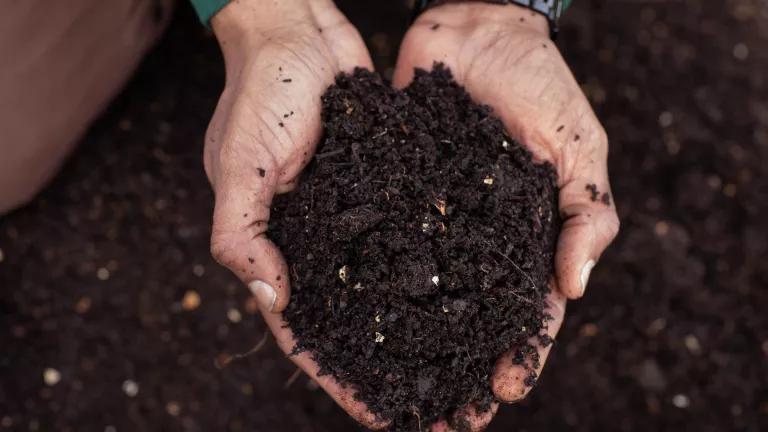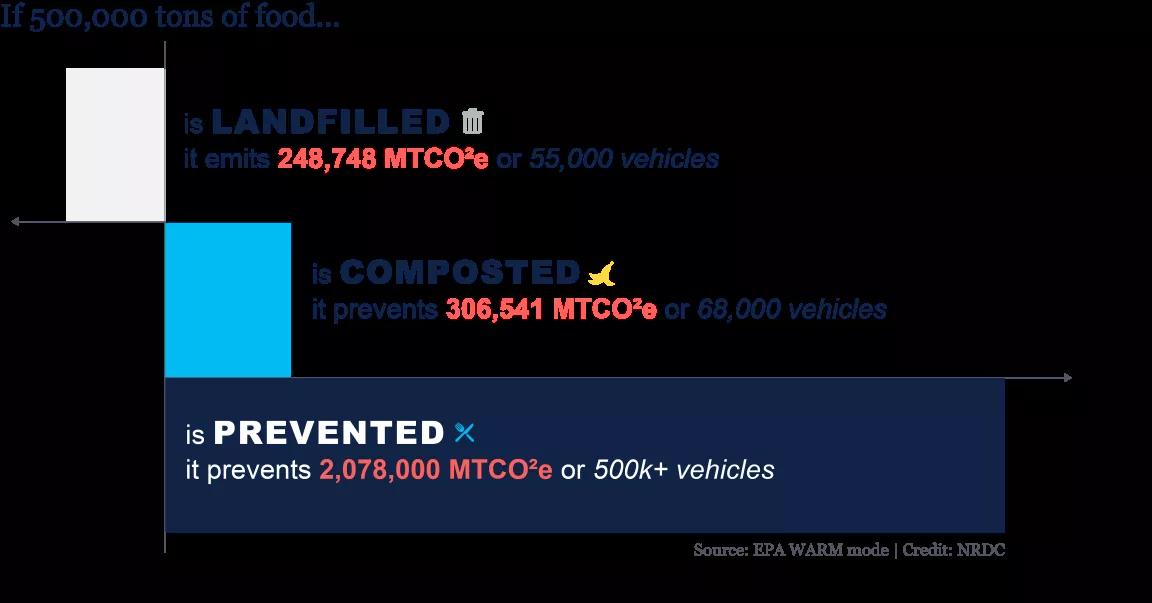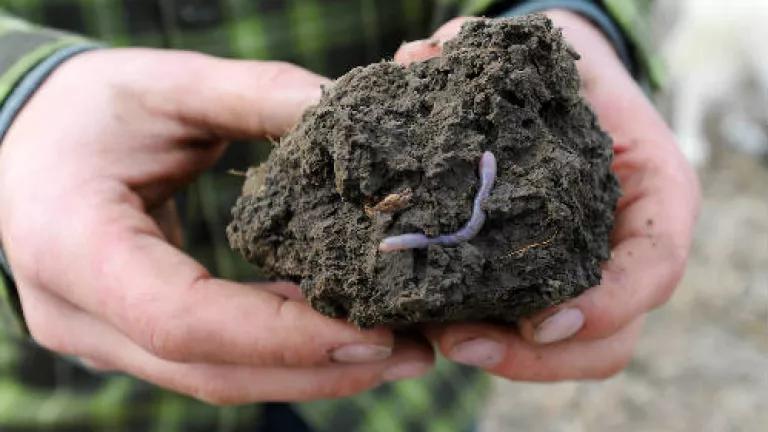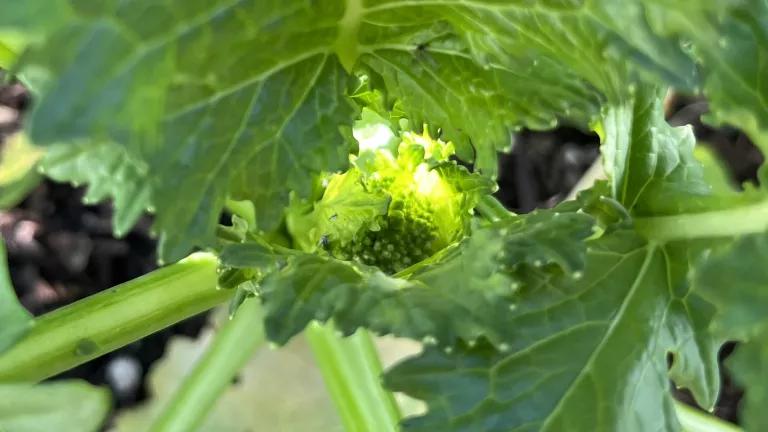Food Waste Funding Opportunity: Climate Pollution Reduction Grants
The Climate Pollution Reduction Grants can offer key food waste reduction funding and support.

Compost at Baltimore Compost Collective
© MurmurRing/Miriam Doan
The Climate Pollution Reduction Grants (CPRG) offer a historic opportunity to advance food waste reduction. Recognized as the most impactful climate solution by Project Drawdown, food waste reduction plays a pivotal role in mitigating the climate crisis, because it accounts for 8-10% of global greenhouse gas emissions. Food waste’s interconnected solutions also have equity, health, and biodiversity impacts.
Greenhouse gases (GHG) are emitted at every stage of the food supply chain – from producing synthetic fertilizer additives, to cooling and transporting perishables, and finally with food waste rotting in landfills. Many of these GHG emissions are short-lived climate pollutants, also known as “super pollutants,” making their impact relevant for the immediate future since they are released into the atmosphere more quickly and are much more potent than carbon dioxide.
CPRG, authorized under the 2022 Inflation Reduction Act, provides $5 billion to states, local governments, tribes, and territories to develop and implement ambitious plans for reducing GHG emissions. These grants represent first-of-a-kind investments in climate solutions. The first phase of the grant allocation includes $250 million for nearly every state, four territories, 90 tribes and numerous metropolitan areas to develop a Priority Climate Action Plan (PCAP) to reduce emissions from six key sectors (electricity generation, industry, transportation, buildings, agriculture/natural and working lands, and waste management). The second phase includes $4.6 billion for implementation grants to complete measures outlined in the PCAPs.
The grant opportunity places values on specific components of the proposed projects:
Community benefits:
Community benefits are the highest ranked evaluation criteria. Projects are expected to benefit low-income and disadvantaged communities based on meaningful engagement with and input from these communities. Composting food scraps creates at least twice as many jobs as landfills and four times as many jobs as incineration facilities. Because 1 in 10 American families is food insecure, projects which address food surplus redistribution will have the co-benefit of addressing hunger and health related concerns in addition to climate benefits. Similarly, nearly 80% of municipal waste incinerators and landfills are in lower-income areas and on Indigenous lands, where they disproportionately affect communities of color. By prioritizing community engagement—and ideally centering community driven efforts—food waste reduction focused CPRG grants can ensure that jobs and infrastructure are benefiting communities that have historically deal with the negative economic, health and environmental impacts from air polluting incinerators and landfills. Additionally, projects that use finished compost to amend soils provide benefits to community by building healthier soils and reducing the impact of climate-change-driven weather events like droughts and floods. Compost procurement can be part of implementation projects in other key sectors such as industry, transportation, buildings, agriculture/natural and working land. For example, new transit lines or multi-family affordable housing can procure finished compost for construction and landscaping and increase community benefits for those sectors.
Near-term GHG reductions:
The evaluation criteria stress the need to achieve GHG reductions in the near term (by 2030) more so than longer term reduction measures (by 2050). Therefore, projects which address super pollutants’ immediate high potency contributions to global warming, like a shovel-ready composting project that can immediately pull food from the landfill and avoid those landfill methane emissions, may be more likely to receive funding.
Transformative impact:
The CPRG application criteria gives more weight to projects that “have the potential to create transformative impact or impacts that can lead to significant additional GHG reductions emissions” which includes projects that tackle “hard-to-abate sectors where GHG emissions reduction measures are not widely adopted.” This can apply to strategies to keep food out of landfills where total emissions are decreasing, but methane emissions from food waste are increasing as more food is sent to landfills. If we can keep that food out of the landfill, not only will we see landfill emissions reductions, but we will see upstream reductions across the food supply chain where efficiencies and improvements have been made. The hardest to abate but highest impact strategies should prevent food from becoming waste because, while difficult to measure, the environmental benefits of preventing food waste are untapped and wide reaching. Using EPA's WARM tool, if we prevented just 500,000 tons of food currently going to waste we potentially could mitigate over 2 million MTCO2e, or the equivalent of emissions from over 500,000 vehicles while the climate benefits from composting 500,000 tons are considerably less at 307,000 MTCO2e, or 68,000 vehicles. The following figure illustrates the comparative impact of prevention versus the emissions associated with composting and landfills.
Cost effectiveness:
The criteria give weight to the cost effectiveness of the GHG reduction measures, and the reasonableness of the costs needed to accomplish the proposed goals. ReFED’s solution database outlines the cost benefits of and the emissions reduction potential of various food waste reduction solutions. For example, educating residents about ways to prevent food waste in their homes would cost $63 per ton of food waste diverted but would have a financial benefit of $5,000 per ton (mostly to consumers who save money on food they no longer waste) and save 5.79 Metric Tons of CO2e.
Here are our recommendations to ensure food waste receives needed CPRG funding:
Assess the GHG inventory:
The primary objective of CPRG is to significantly reduce GHG emissions. Depending on which elements are prioritized, GHG modeling may not completely reflect the GHG reduction potential inherent in food waste management. Plans should utilize consumption metrics and prioritize reductions on a 20-year timeline which will elevate the need to target short-lived climate pollutants, such as methane. Industrious Labs and Rocky Mountain Institute developed this helpful guide for measuring organic waste and landfill methane strategies.
Build a robust community engagement process:
Ensure that community members are engaged in a meaningful manner. A core element of our Food Matters work with cities is buy-in and engagement with community members because we have seen how transformative these conversations and input can be in the impact and long-term success of programs. The first phase of the grants was expressly given to help with community engagement, therefore all entities that received the planning grants should have an open comment opportunity that is transparent and easily accessible to members of low-income and disadvantaged communities. Similarly, through community engagement, CPRG can get closer to accomplishing the Federal Government’s Justice40 goal of 40% of overall benefits of federal investments going to chronically divested communities.
Address all key areas in the PCAPs:
In developing the PCAPs, grantees should address all six key sectors to reduce emissions, including food waste as part of the waste management section. Numerous examples of existing CAPs highlight the connections between climate action and food waste reduction, as well as a Toolkit with model provisions. If you are not already engaged in the PCAP process, see who is leading the PCAP in your area.
Emulate existing food waste reduction strategies:
There are many existing examples of targets and activities to reduce food waste in climate action plans including:
- Columbus’s Climate Action Plan includes targets to reduce landfilled organic waste 50% by 2030 and 90% by 2050. An implementation grant to fund composting would jumpstart their ability to meet their goal. With food waste reduction fully integrated into an existing climate action plan, Columbus has a shovel-ready project ready to reduce food waste and cut GHG pollution in the near future.
- San Francisco’s 2021 Climate Action Plan includes a goal to “reduce the carbon footprint of the food system by reducing waste, promoting climate friendly diets and getting excess food to communities in need (p.108).” The plan includes a list of strategic partnerships that will advance the goal as well as procurement opportunities for the city to lead by example.
- Shelby County, Tennessee, encompassing Memphis, has sector targets and implementation actions in their Climate Action Plan, and submits annual reports on progress. Specific food waste measures include exploring programs and incentives for composting food waste, considering regulations for waste haulers to offer food waste composting, updating state landfill regulations to discourage food waste, and exploring a municipal curbside composting program.
- Maryland’s Climate Pathway outlines how the state can reach a net-zero economy by 2045. Maryland’s strong suite of policies including landfill methane regulations, Sustainable Materials Management policies like a mandatory organics recycling law, and budding waste diversion programs put the state on target to reduce emissions significantly. The addition of accurate and real-time data, public education on zero waste strategies, and ensuring universal access to composting will help Maryland reduce emissions and achieve environmental health benefits.
Develop shovel-ready competitive implementation projects:
Implementation plans need to be developed imminently as they are due April 1, 2024 for the general competition. Throughout the process, remember that eating food before it becomes waste has the broadest environmental benefits. Weaving strategies to prevent food from becoming waste in the first place—like including measures to encourage residents to consume their food before it spoils when designing residential composting projects—can increase the magnitude of GHG reductions. Proven examples of projects which can be implemented quickly to reduce food waste and cut GHG emissions include:
- Enacting an organic waste landfill ban;
- Implementing curbside compost collection, community composting, or compost drop-offs;
- Running a consumer education campaign to help residents reduce food waste in their own homes;
- Implementing incentives to reduce waste such as a pay as you throw (PAYT) policy;
- Providing food waste reduction grants including grants for preventing food from becoming waste or rescuing surplus food;
- Funding a food sourcer;
- Mandating reporting because the act of separating and measuring waste is a key intervention opportunity;
- Procuring compost especially across other related PCAP projects, e.g. new rail lines or housing developments.
Eliminating food waste does not start or stop with CPRG. It is a continuous effort that involves planning, partnership development, and project implementation at various scales and timelines. By working towards these goals, places around the country can position themselves favorably for future grant opportunities and pave the way for both immediate and long-term progress.






